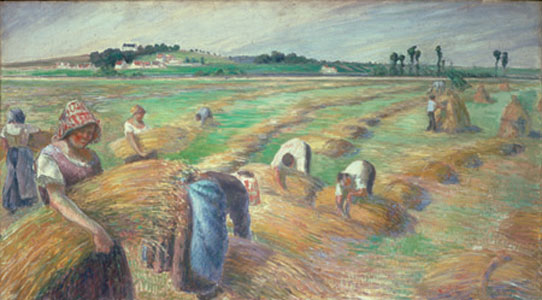
Like a revolutionary manifesto thrown over the transom, a powerful exhibit of the politically inspired paintings by 19th century anarchist artist Camille Pissarro delivers a clear message of inspiration and solidarity to today’s Occupy movement. That the special exhibit “Pissarro’s People” (through January 22nd) at San Francisco’s prestigious Legion of Honor Museum , is co-sponsored by a major banking villain, Wells Fargo (along with Bechtel Foundation, funded by the well-known corporate plunderer), only adds to the delight of this exceptionally well-researched revelation of the real French impressionist and his radical life.
“Pissarro’s People,” drew attention last summer at Clark University in western Massachusetts. The exhibit has been jointly organized by the Legion of Honor Museum and the Francine Clark Art Institute.
“It is the war of the dispossessed against the dispossessors, the war of the hungry against the fat, the war of the poor against the rich, the war of life against death,” reads the text accompanying Pissarro’s drawing of “Capital” – drawn more than a century ago. The image of a smug and bloated capitalist – surely the predecessor of a 21st century “bankster” – stands above a sea of “the 99%” – the ragged and hungry of 19th century France. This is on page one of the artist’s seminal tome, “Turpitudes Sociales” (Social Disgraces), a collection of 28 drawings of human misery and exploitation, created in 1890, toward the end of his life (1830-1903). The back cover has a rising sun and one word – “ANARCHIE.”
Shocking as it may seem, today’s museumgoers are the first people in the world to see Pissarro’s “Turpitudes Sociales.” As the wall text states, “The album makes its public debut in this exhibition.”
These are powerful ideals that, then and today, are viewed with hostility by those who hold the reins. High on a wall above the display of the Turpitudes are the words of Pissarro’s comrade and fellow anarchist, Peter Kropotkin: “You poets, painters, sculptors, musicians – if you have understood your true mission and concerns of art itself, then take up your pen, your brush, your burin, for the cause of revolution!” – from “Words of a Rebel,” 1885.
This welcome and honest revelation of the true values of the famous Pissarro which resonate so well today can be credited to the exhibit’s curator, Richard Brettell, an internationally recognized expert on impressionist artists. The frankly “sugary” and decorative reputation of Pissarro’s popular work takes on a much deeper aspect as the six rooms of the Legion’s temporary exhibit space gradually unfold his life and beliefs, as expressed in his much less-known works that are displayed. Servants, maids, peasants, farm workers, and market vendors are all painted on large canvasses in reverential form – very unusual subjects for their time. The accompanying text is fresh and deeply knowledgeable.
The first room shows Pissarro’s family, his Jewish roots, his early respect for non-European cultures from a childhood in the Caribbean, and his decision to settle in France – despite his horror at the appalling poverty and inequity of urban Europe of the mid-1800s. An artist all his life, the man had to support a wife and eight children, thus he painted commercially viable pastel works of landscapes and “neutral” subjects in an increasingly pointillist style. It is in the second section of Room 4 that his anarchist ideals and activities are powerfully displayed.
Pissarro lived his beliefs: he married outside of his class and religion (his wife was a French Catholic who had been his mother’s servant), he lived very modestly – mostly in the countryside, and he had many collaborations with other anarchist writers and illustrators whose works are shown in the room with Turpitudes. They were all on a government watch list, but it was several of his close associates who were arrested and imprisoned – not Pissarro. Adding to Pissarro’s fear of repression was the climate of anti-Semitism increasingly prevalent toward the turn of the century.
The title page of “Social Disgraces” shows an old man brooding as he looks down on society from a hilltop, surely a portrait of the disheartened man himself. That Pissarro waited until the end of his life to make the illustrated album – and that it was saved by his family but never published or displayed publicly until 121 years later – is something to ponder in light of the global uprisings that we have today.
Sadly, the great majority of those who see this exhibit are well to do, grey headed, safely cultured folks. Perhaps this is the reason curator Brettell concludes the fourth room with this: “In Pissarro’s era the word Anarchist carried few of the connotations of violent lawlessness it would later acquire. Anarchism referred instead to a world without hierarchy, government, or private property; equal individuals would from cooperative associations dedicated to common goals, prospering through sustainable agriculture, fair industry and craft – as well as ample leisure time. That such a society would only be realized through wholesale political and societal transformation meant that Anarchists also advocated widespread revolution. These calls to act therefore threatened government power.”
The 99% need to see this exhibit! DO NOT miss seeing this voice of encouragement from the past! The Legion of Honor Fine Arts Museum is located in Lincoln Park, northwestern corner of San Francisco, easily accessed by bus. Open Tuesdays through Sundays, 9:30 a.m. to 5:15 p.m. www.legionofhonor.org
“Pissarro’s People” ends on Sunday, January 22. One hopes it will continue to tour extensively.
Image: Pissarro’s “The Harvest.”










